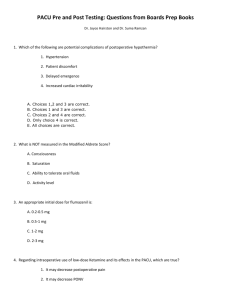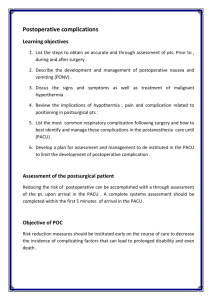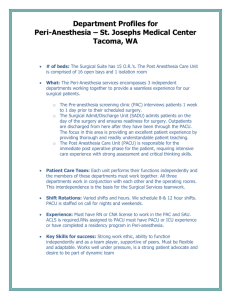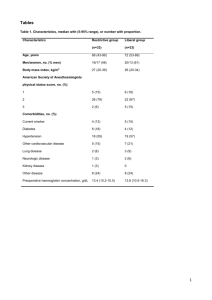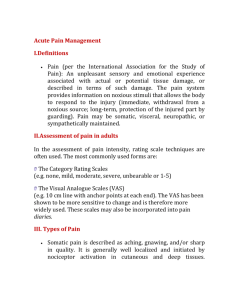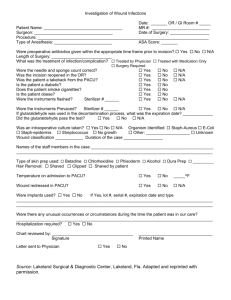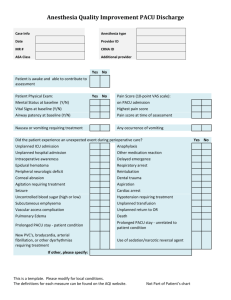Acute Pain Management in the Postanesthesia Care Unit
advertisement
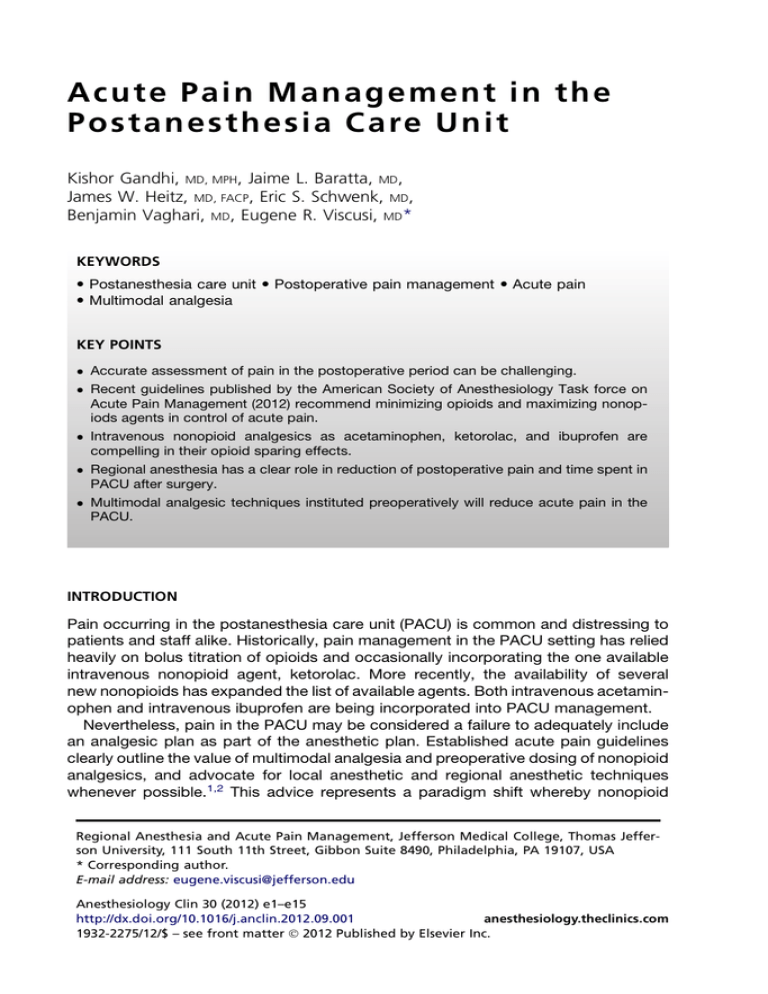
A c u t e Pa i n Ma n a g e m e n t i n t h e P o stane s t h es i a C are Un i t Kishor Gandhi, MD, MPH, Jaime L. Baratta, MD, James W. Heitz, MD, FACP, Eric S. Schwenk, MD, Benjamin Vaghari, MD, Eugene R. Viscusi, MD* KEYWORDS Postanesthesia care unit Postoperative pain management Acute pain Multimodal analgesia KEY POINTS Accurate assessment of pain in the postoperative period can be challenging. Recent guidelines published by the American Society of Anesthesiology Task force on Acute Pain Management (2012) recommend minimizing opioids and maximizing nonopiods agents in control of acute pain. Intravenous nonopioid analgesics as acetaminophen, ketorolac, and ibuprofen are compelling in their opioid sparing effects. Regional anesthesia has a clear role in reduction of postoperative pain and time spent in PACU after surgery. Multimodal analgesic techniques instituted preoperatively will reduce acute pain in the PACU. INTRODUCTION Pain occurring in the postanesthesia care unit (PACU) is common and distressing to patients and staff alike. Historically, pain management in the PACU setting has relied heavily on bolus titration of opioids and occasionally incorporating the one available intravenous nonopioid agent, ketorolac. More recently, the availability of several new nonopioids has expanded the list of available agents. Both intravenous acetaminophen and intravenous ibuprofen are being incorporated into PACU management. Nevertheless, pain in the PACU may be considered a failure to adequately include an analgesic plan as part of the anesthetic plan. Established acute pain guidelines clearly outline the value of multimodal analgesia and preoperative dosing of nonopioid analgesics, and advocate for local anesthetic and regional anesthetic techniques whenever possible.1,2 This advice represents a paradigm shift whereby nonopioid Regional Anesthesia and Acute Pain Management, Jefferson Medical College, Thomas Jefferson University, 111 South 11th Street, Gibbon Suite 8490, Philadelphia, PA 19107, USA * Corresponding author. E-mail address: eugene.viscusi@jefferson.edu Anesthesiology Clin 30 (2012) e1–e15 http://dx.doi.org/10.1016/j.anclin.2012.09.001 anesthesiology.theclinics.com 1932-2275/12/$ – see front matter Ó 2012 Published by Elsevier Inc. e2 Gandhi et al analgesics become the cornerstone, with preoperative and around-the-clock dosing with opioids used as adjunctive analgesics on an as-needed basis. For the patient, awakening from general anesthesia in the PACU and suffering severe pain is extremely distressing. Titration of opioids as rescue often leads to common opioid side effects including nausea, vomiting, and sedation. Patient satisfaction is intimately connected with pain management and side effects experienced as a consequence of pain treatment. Satisfaction is an increasingly important driver for market share and payment. Patient satisfaction data are now being reported via Hospital Consumer Assessment of Healthcare Providers and Systems (HCAHPS, also known as CAHPS hospital survey).3 As part of the Affordable Care Act 2010, the Centers for Medicare and Medicaid (CMS) have established hospital reimbursement based on HCAHPS scores.4 Regarding hospital monetary costs, PACU time is expensive and second only to operating room time. Pain in the PACU or resulting side effects from opioids are significant drivers for prolonged PACU length of stay. Prevention is clearly the best medicine when it comes to pain in the PACU. Even with planning, pain in the PACU is still a likely occurrence. Application of standard multimodal analgesic approaches will produce the best results. Nonopioid analgesics should be considered first. Intravenous acetaminophen and intravenous nonsteroidal anti-inflammatory drugs (NSAIDs; ketorolac or ibuprofen) should be considered. Rescue regional anesthetic techniques are particularly effective following orthopedic procedures. Many patients, particularly in the ambulatory setting, will be able to tolerate oral medications at some point during their PACU stay. In addition to common oral agents (acetaminophen and NSAIDs), this allows the addition of specific agents for neuropathic components of pain (pregabalin and gabapentin). Opioids are generally effective for nociceptive pain, notwithstanding their side effects, but are not very effective for inflammatory or neuropathic pain. Clinicians have been taught to assess pain with a number. However, a single dimension of assessment misses an understanding of the specific type or types of pain that a patient is experiencing. Therefore, pain assessment should include not only an intensity rating but also a careful description of the character of pain, so that a rational multimodal approach can be planned to target all aspects of pain. Pain following most procedures is more likely to be a blend of sharp, throbbing pain, but often includes burning and possibly muscle spasms. A single drug, particularly an opioid, is unlikely to effectively treat this mixed type of pain. PAIN ASSESSMENT IN THE PACU The accurate assessment of a patient’s pain in the postoperative period poses a significant challenge. According to a recent survey, experiencing postoperative pain is the most common concern of patients preoperatively and despite better pharmacotherapy and improved technology, the majority of patients continue to experience moderate to severe pain postoperatively.5 As it is well known that uncontrolled pain may hinder rehabilitation, increase the length of stay and rate of readmission, and increase the risk of postoperative morbidity, and has been implicated as a risk factor for the development of chronic pain, it is imperative to appropriately assess pain postoperatively and treat it effectively.6,7 In 1999, the Veteran’s Hospital Administration led to the development of the “fifth vital sign,” to ensure that a proper pain assessment would be consistently done.8 Subsequently multiple organizations have continued to emphasize the importance Acute Pain Management in the PACU of pain management. However, pain is complex in nature, thus making it difficult to accurately assess. There are 5 accepted types of pain: nociceptive, neuropathic, psychogenic, mixed, and idiopathic.9 Nociceptive pain may be described as aching, sharp, throbbing pressure, or stiffness. Neuropathic pain is often burning, tingling, crushing, or stabbing, whereas psychogenic pain entails complaints of pain that may not match the presenting symptoms. A mixed pattern of pain contains characteristics of neuropathic and nociceptive pathways, and idiopathic pain is that of unknown origin. Despite the fact that the experience of pain is universal amongst us all, it remains difficult for caregivers to understand each individual patient’s perception of noxious stimuli. To accurately assess pain, it is not sufficient to merely address the intensity of pain but to understand the nature and character of it. No single therapeutic agent is effective for the varying types of pain discussed herein. When addressing pain postoperatively, qualitative information such as “is it sharp, dull, stabbing, burning, shocking, or spasm-like” as well as its location, onset, and exacerbating and relieving factors must be delineated in addition to a quantitative measures of pain.9 There are numerous tools to assess pain including observer and self-report scales; however, observer-based assessment should only be reserved for nonverbal and cognitively impaired patients. “Without reproducible biologic or precise diagnostic tests that measure pain,”10 the self-report remains the gold standard.9 While no single assessment tool has been proved most effective, numerous standardized, reproducible methods have been described as useful in assisting in pain assessment, including the Numeric Rating Scale (NRS), Verbal Rating Scale (VRS), Visual Analog Scale (VAS), and Faces Pain Scale (FPS). These scales are merely one-dimensional and must be used in conjunction with a more detailed description of each patient’s pain. Nonetheless, they have been found to be useful in the postoperative setting.9 The NRS is the most commonly used method and is reliable for patients with mild to moderate cognitive impairment, whereas the VRS is simple to use but may lack sensitivity to treatment-induced changes when compared with the NRS because of the limited number of descriptors. The VAS scale has been proved effective in the clinical and research setting; however, its use may be time-consuming as well as confusing for the cognitively impaired patient. The FPS scale is the most widely used scale in the pediatric population but may also have utility in the cognitively impaired patient or in patients with language barriers.9 Regardless of the pain assessment tool used, however, the intensity of the pain and the character of pain postoperatively must be addressed to develop an effective treatment plan. OPIOIDS IN THE PACU Opioids are an important component of analgesia for the surgical patient in the PACU. Recent guidelines (American Society of Anesthesiologists [ASA] Task Force 2012) recommend maximizing nonopioid agents and using opioids as adjuncts when needed. Despite their many unwanted side effects, intravenous (IV) opioids can provide rapid, effective analgesia for patients with moderate to severe pain in the perioperative period. The most commonly used IV opioids in the PACU are morphine, hydromorphone, and fentanyl. Morphine is the prototypical opioid agonist and the standard to which all others are compared. It is the most widely used opioid worldwide for acute pain management.11 It has moderate analgesic potency because of its relative hydrophilicity, as well as a slow onset and intermediate duration of activity. Although its half-life is 2 hours, its duration of action is closer to 4 to 5 hours.12 Morphine causes dose-dependent e3 e4 Gandhi et al histamine release, which decreases systemic vascular resistance.13 Morphine is metabolized primarily in the liver into morphine-3-glucuronide and morphine-6glucuronide, the latter of which has significant analgesic activity.14 Because these metabolites are excreted by the kidneys, their analgesic and sedating effects can be potentially dangerously prolonged in patients with renal failure.14,15 Hydromorphone is a semisynthetic opioid that is 4 to 6 times more potent than morphine, and has a slightly shorter duration of action and more rapid onset. It is metabolized principally in the liver and is excreted renally into inactive compounds, making it a good choice in patients with renal impairment. It may have a slightly lower incidence of pruritus and sedation compared with morphine.11 It is useful in the postoperative setting where rapid analgesia is desired, and may be particularly effective for opioid-tolerant patients.11 Fentanyl is a synthetic opioid that is 50 to 80 times more potent than morphine. It has a rapid onset of action (within 10 seconds of IV injection) owing to its high lipid solubility. Duration of action of a single dose of fentanyl (100 mg) is about 1 to 1.5 hours.16 Because of its hepatic metabolism to inactive compounds, fentanyl is a good choice for patients with renal failure. It can be very effective in the PACU setting when rapid analgesia is needed; however, additional doses will likely be needed because of its short duration of action. The choice of opioid depends on the clinical situation. Although extensively studied, morphine has drawbacks in a PACU setting, namely, its relatively slow onset and histamine release. Hydromorphone and fentanyl may be better choices when rapid control of pain is desired, especially as more hospitals put emphasis on minimizing PACU length of stay. In the authors’ practice, hydromorphone has been found to be more effective for opioid-tolerant patients. Regardless of the choice of opioid, the most commonly used method of delivery is IV patient-controlled analgesia (PCA). PCA improves patient satisfaction17,18 and leads to superior analgesia when compared with as-needed parenteral opioids.18 Patients should be given a loading dose of opioid before initializing PCA to maximize its efficacy and to establish a baseline level of analgesia. One recommendation is to administer loading doses of an opioid in the PACU until the pain score is 4 or less out of 10 or a respiratory rate of fewer than 12 breaths per minute limits further treatment.19 Using the same opioid for the loading dose and the PCA is logical, as it allows for providers to observe patient response to loading and help predict PCA requirements. However, there is no evidence to support it being necessary or advisable to “load” with the same opioid that will be delivered by PCA. Quality of analgesia and side effects do not appear to be affected by using different opioids to initiate analgesia. It is important to remember that PCA technology is intended to maintain analgesia but not titrate to comfort. Therefore, it is critical that patients are titrated to adequate analgesia before initiating PCA mode. The use of continuous background infusions (basal infusions) increases the risk of respiratory depression.19 Opioid agonists produce dose-dependent side effects that can occur in the PACU, including pruritus, nausea and vomiting, urinary retention, and respiratory depression. These effects can range from annoying (pruritus) to life-threatening (respiratory depression). The origin of pruritus is unclear, but its reversal with naloxone administration suggests an opioid receptor–mediated pathway. Antihistamines such as diphenhydramine are typically given to treat opioid-induced pruritus, but their apparent efficacy may be more related to their sedative properties. Most other classes of drugs studied, including gabapentinoids20 and glucocorticoids,21 have yielded disappointing results, although droperidol may have some efficacy.22 Opioid antagonists Acute Pain Management in the PACU such as naloxone will relieve pruritus,23 but the possibility of decreased analgesia exists. The practitioner in the PACU is left with few effective options. Opioid-induced nausea and vomiting is mediated via opioid receptors in the brainstem, and occurs in about one-quarter of patients receiving opioids.24 Because postoperative nausea and vomiting (PONV) contributes to delayed PACU discharge,25 its prevention and treatment are paramount. The most effective agents appear to be dexamethasone21,26 and the serotonin-3 (5-HT3) inhibitors.27,28 These agents appear to exert greater effects in combination, either with each other or with droperidol.29 Urinary retention may or may not present in the PACU. Opioids reduce detrusor muscle contractions, leading to urinary retention.30 Urinary retention can be reversed with a pure opioid antagonist (naloxone, 0.01 mg/kg IV) or a peripheral opioid antagonist (methylnaltrexone, 0.3 mg/kg IV). The most feared complication of opioid therapy is respiratory depression, which typically presents as a decrease in respiratory rate mediated by m-receptors in the brainstem.13 The incidence of postoperative opioid-induced respiratory depression is somewhere between 0.09% and 0.5%.31 However, certain populations, such as the elderly, neonates, and those with obstructive sleep apnea, are at higher risk, and opioids should be given cautiously to these groups. The only effective treatment for opioid-induced respiratory depression is an antagonist such as naloxone or naltrexone, and the duration of action of these agents is shorter than that of the opioid agonists, making “renarcotization” a real possibility. NONOPIOIDS IN THE PACU Nonopioid analgesics are a vital adjunct to opioid-based medications for providing analgesia in the PACU setting. A mainstay of nonopioid analgesia is acetaminophen, which comes in 3 major forms: oral, rectal, and IV. Additional IV nonopioids include the NSAIDs ibuprofen and ketorolac. IV offers advantages over oral and rectal administration, with faster onset and use in patients unable to ingest orally. A major downside of these IV medications is the increase in cost per dose. Acetaminophen functions via inhibition of cyclooxygenase, though with little to no peripheral activity, producing effective analgesia as well as an antipyretic effect. NSAIDs also function via inhibition of cyclooxygenase but also have powerful peripheral anti-inflammatory properties. These medications offer a different mechanism of analgesia from opioids, and tend to be better tolerated overall secondary to an improved side-effect profile. Acetaminophen, depending on its method of delivery, has a range of dosages. Common oral doses routinely range from 650 to 1000 mg every 6 hours while IV acetaminophen is packaged in 1000-mg vials that can be administered every 6 hours. The maximum daily dose for both oral and IV is 4000 mg in those ages 13 years and up who weigh more than 50 kg. Common adult rectal dosages range from 1 to 2 g, typically given as a single dose because absorption and resulting plasma levels are unpredictable. There has been significant past research to determine the onset of analgesic effects between these 3 common acetaminophen delivery modalities to provide optimal patient care in a PACU setting. A study compared the onset of analgesia in patients receiving third molar surgery after IV bolus, infusion, and oral acetaminophen.32 Researchers found the onset of analgesia to be 3, 5, and 11 minutes after IV bolus, infusion, and oral administration, respectively.32 Despite the onset time advantage and potentially higher plasma acetaminophen levels of IV administration, another study comparing PACU pain scores in patients receiving either IV or oral acetaminophen status post knee arthroscopy ultimately showed no difference between these two groups.33 For rectal administration, plasma acetaminophen levels were e5 e6 Gandhi et al shown to not yet peak or reach levels required for maximum antipyretic effect even at 4 hours after 2 g rectal administration in postoperative patients.34 Plasma levels for maximal acetaminophen analgesia have not yet been determined. A study directly comparing plasma levels of 1 g IV with 1 g rectal acetaminophen in patients after heart surgery demonstrated peak levels at 40 minutes for IV and no detectable plasma levels for rectal even at 80 minutes.35 The significant delay of rectal acetaminophen in achieving effective plasma levels greatly limits the utility of this modality as a rescue medication in the PACU setting. Acetaminophen’s site of action is in the central compartment and thus must penetrate into cerebrospinal fluid (CSF) to be effective. CSF levels increase more quickly and achieve greater levels if there is a more rapid increase in plasma levels. Hence, the IV route of delivery may in theory be more effective than oral or rectal administration. Both oral and IV acetaminophen can be of benefit in providing analgesia in the PACU. Oral doses of 1 g are effective in reducing acute pain by 50% in 4 to 6 hours in patients with moderate to severe pain.36 IV acetaminophen has demonstrated significant reductions in pain scores and opioid consumption in comparison with placebo when administered up to 24 hours postoperatively.37,38 Acetaminophen overall has minimal side effects, with the main concern being hepatotoxicity, more concerning in patients with chronic ethanol intake and the elderly. Although advanced elderly patients have demonstrated higher plasma acetaminophen levels when compared with younger patients, a recent subset data analysis of 3 studies involving patients older than 65 years receiving IV acetaminophen demonstrated an excellent safety profile overall.39,40 Ketorolac as an IV formulation has long been a useful nonopioid adjunct in managing acute surgical pain. The optimum timing, dose, route (IV vs intramuscular) has been much explored in the literature. Whereas 30 mg IV ketorolac when given every 6 hours has been shown consistently to reduce opioid consumption and pain scores, the data for single-dose injections and use as rescue in the PACU has been more mixed.41 A study directly comparing 30 mg of IV ketorolac with 50 mg of fentanyl for postoperative pain management in outpatients showed that although fentanyl was more effective in reducing pain scores at 15 minutes, no differences were observed at 30 and 150 minutes. When checked at 6 hours the ketorolac patients showed lower pain scores.42 A later study of single-dose ketorolac, this time using 60 mg of IV ketorolac in patients undergoing outpatient anorectal surgery, found that only 5% of patients treated with ketorolac complained of pain relative to 34% given placebo. In addition, only 2% of the patients given ketorolac required any oral medications in the PACU.43 With the intention to help clarify the optimum dosage of single injection ketorolac, a recent meta-analysis examining perioperative single-dose ketorolac found a clear postoperative benefit when 60 mg was given, with results being mixed when patients were given only 30 mg.44 To explore optimum timing of single-dose ketorolac, a study in patients undergoing minor orthopedic surgery found that preoperative ketorolac 30 mg IV was no more effective than the same dose of ketorolac given as a rescue medication in PACU.45 Another study exploring timing in orthopedic patients given 60 mg of intramuscular ketorolac either preoperatively or postoperatively found that the preoperative dose was more effective in reducing pain scores in recovery.46 While the exact timing and most effective dosage is unclear, overall the data suggest that ketorolac is an effective analgesic when incorporated into a postoperative pain management plan or used as a rescue medication. Intravenous ibuprofen, approved for use by the Food and Drug Administration (FDA) in 2009, is another potentially useful IV nonopioid adjunct for use in the perioperative Acute Pain Management in the PACU period. Typical adult doses range from 400 to 800 mg every 6 hours, similar to oral dosing. At present, evidence for single-dose IV ibuprofen in the PACU setting is scant. However, compelling evidence exists to support ibuprofen’s potent analgesic effect and opioid-sparing capacity when given in the perioperative period as a standing medication. A multicenter, randomized, double-blind, placebo-controlled trial of 800 mg of IV ibuprofen given every 6 hours following abdominal hysterectomy showed a 19% reduction in opiate use at 24 hours with reductions in both pain scores at rest and with movement.47 A second double-blind placebo-controlled trial of 800 mg IV ibuprofen given throughout the perioperative period also displayed similar reductions in pain scores and opiate consumption in adult orthopedic patients.48 As the prior 2 studies compare ibuprofen with placebo using 800-mg doses, another study included 400-mg dosing when compared with placebo.49 This study found that while 400 mg was effective in reducing pain scores, the 800-mg group displayed even greater reductions in pain scores, further demonstrating IV ibuprofen as a useful nonopioid analgesic adjunct. REGIONAL ANALGESIA IN THE PACU As the recent ASA Task Force on Acute Pain Management guidelines1,2 clearly emphasize a multimodal approach to analgesia in the perioperative setting, regional analgesia has a clear role in reducing postoperative pain in the PACU and should be used whenever possible. Regional analgesia has been demonstrated to be superior to opioids in the management of postoperative pain, especially in the orthopedic populations. For instance, when comparing continuous peripheral nerve blockade (CPNB), regardless of catheter location, the analgesia provided was superior to that of opioid analgesia with the added benefit of fewer opioid-related side effects.50 Brachial plexus CPNB, when used in the inpatient and outpatient settings, has demonstrated prolonged pain control of up to 72 hours, less opioid use, faster resumption of physical therapy, fewer sleep disturbances, and overall increased patient satisfaction.51 In addition, with ever-increasing health care costs, much attention has been focused on reducing the length of hospital stay. Previous studies have demonstrated superior recovery profile while using a variety of different peripheral nerve block techniques following various ambulatory orthopedic procedures.52 When comparing infraclavicular nerve block (INB) to “fast-track” general anesthesia with a laryngeal mask airway for hand and wrist surgery in a prospective randomized trial, investigators found more patients in the INB group met the criteria to bypass the PACU compared with patients in the general anesthesia group, and were able to ambulate earlier, while fewer INB patients had pain on arrival to the PACU and none requested pain treatment. In addition, time-to-discharge times were shorter for the INB group and adverse events occurred less frequently in patients undergoing infraclavicular nerve block.52 Subsequently the same investigators demonstrated similar results when comparing interscalene brachial plexus block (ISB) with fast-track general anesthesia for patients undergoing outpatient rotator cuff surgery. Again, results showed patients who received ISB bypassed the PACU more frequently, experienced less pain, ambulated earlier, and met discharge criteria sooner, while reporting superior satisfaction with their care when compared with the general anesthesia group.53 When examining the effectiveness of peripheral nerve blockade (lumbar plexus plus sciatic block) following outpatient knee arthroscopy, the peripheral nerve block group again resulted in higher likelihood to bypass phase 1 PACU as well as faster time to discharge when compared with general anesthesia with laryngeal mask airway.54 Of note, in all of these studies the mean operating room time did not differ between groups; however, time e7 e8 Gandhi et al for induction was longer for the peripheral nerve block group.52–54 In a large metaanalysis comparing regional versus general anesthesia in ambulatory surgery, a study found that both central neuraxial and peripheral nerve block resulted in increased induction time, reduced pain scores, and decreased need for postoperative analgesics.55 Whereas central neuraxial block was associated with an increase in total ambulatory surgery unit time, peripheral nerve block was associated with decrease PACU need and decreased nausea postoperatively, but not overall decreased ambulatory surgery unit time. Nonetheless, with health care cost-saving measures at the forefront and patient satisfaction now a component in determining payment,3 regional analgesia clearly has an important role in postoperative pain management. While no studies exist to actually examine the effectiveness of rescue peripheral nerve blockade because the majority of regional anesthetics are performed preoperatively to assist in intraoperative pain management, the authors have a low threshold for rescue blockade in the PACU following a block failure. On arrival in the PACU, each patient who has received a regional anesthetic, including brachial plexus, lumbar plexus, femoral, saphenous, sciatic, as well as transversus abdominis plane block, is assessed for adequacy of sensory as well as motor blockade, and a pain assessment is completed. If the regional block is determined to be inadequate, the authors first advocate a bolus of the continuous peripheral nerve catheter (if one is in place) of 10 mL 2% lidocaine, as an increased volume of local anesthetic may sufficiently improve the blockade. However, if a single-shot peripheral nerve blockade was done in the distribution of the patient’s current pain or if peripheral nerve catheter bolus proves unsuccessful, a rescue block under ultrasound guidance will be performed in the PACU, typically using 20 mL 0.5% ropivacaine for an average-sized adult. The utility of expedient pain assessment in the PACU cannot be emphasized enough. In addition, in the event of a combination peripheral nerve blockade, it is imperative to delineate the distribution of pain to appropriately determine which rescue block is necessary. Determining the location of the pain is especially important following interscalene catheter placement for shoulder surgery. Common complaints encountered after shoulder surgery is pain in the axilla, prompting many providers to bolus the catheter and assume block failure. However, as the brachial plexus encompasses C5-T1 nerve roots, the intercostobrachial nerve (T2) is missed during an interscalene block. Treatment of persistent axilla pain following shoulder surgery can be achieved via a supplemental analgesia with nonopioids as well as opioids, or a subcutaneous cuff of local anesthetic (10 mL 2% lidocaine) can be deposited in the axilla to effectively block the intercostobrachial nerve. As the benefits of regional analgesia have clearly been delineated, the authors believe that assessment of the peripheral nerve block and a proper pain assessment in the PACU is imperative for successful postoperative pain management. MANAGING EPIDURALS AND CONTINUOUS PERINEURAL CATHETERS IN THE PACU To avoid any complications, all patients with an indwelling epidural catheter must be given a test dose before an infusion is started. The possibility of catheter migration into the intrathecal and intravenous space is estimated to be 0.15%.56 A routine practice involves giving a test dose of local anesthetic (2% lidocaine with dilute epinephrine [1:100,000]) to rule out intravascular or intrathecal placement before an infusion is started in the PACU. Epidural infusions with local anesthetics are commonly started in the PACU. The choice of local anesthetic with or without opioids is institution-based. The advantage of opioids in the infusion includes better control of dynamic pain relief and less Acute Pain Management in the PACU hypotension when compared with local anesthetic infusion alone. Studies have shown that dilute local anesthetic infusions (0.2% ropivacaine, 0.1% bupivacaine, or 0.1% levobupivacaine) combined with sufentanil (0.8 mg/mL) and fentanyl (1–4 mg/mL) may lead to greater dynamic pain control for major abdominal, thoracic, and orthopedic surgeries.57–59 Some institutions may avoid opioids in the infusion because of concerns for respiratory depression, pruritus, nausea, and vomiting. In cases where opioids are avoided, adjuvants such as epinephrine, clonidine, and ketamine can be added to the infusion. Opioids may be administered by IV PCA along with nonopioid agents. The use of epinephrine and clonidine in infusion leads to greater analgesia; however, clonidine may be associated with hypotension.60 A multimodal regimen consisting of acetaminophen, NSAIDs, gabapentin or pregabalin, and IV PCA may also replace the need for opioids in the local anesthetic infusion. Furthermore, there may be marginal differences in efficacy when comparing patient-controlled epidural infusion versus strict infusion of local anesthethic.56 Over the last decade, the use of peripheral nerve catheters has been increasing significantly since studies showed brachial plexus catheters to reduce resting and dynamic pain, sleep disturbances, opioid consumption, and opioid-related side effects.56 Infusion of local anesthetic can be delivered with a perineural catheter with a continuous infusion, bolus dose only, or the combination of the two. Evidence is currently lacking as to the superiority of any one of these techniques with continuous peripheral catheters.51 A published review of continuous nerve catheters shows that when patient-controlled bolus injection is added to a low basal infusion, there is a decrease in motor block, decrease in insensate extremity, and low consumption of local anesthetic.51 The authors’ practice is to use a dilute local anesthetic, ropivacaine 0.2% at a rate of 6 to 8 mL/h for upper extremity catheters and 8 to 10 mL/h for lower extremity catheters. Patients may display breakthrough pain with the use of a continuous catheter. This pain is best managed in the PACU with a bolus of dilute local anesthetic or the use of a PCA for pain relief. The use of ambulatory catheters (including infraclavicular, interscalene, and popliteal) results in lower pain scores at rest and with movement as well as lower oral opioid analgesic use.61 The concentration and rate of local anesthetic infusion in the ambulatory setting should be tailored to maximize analgesia while minimizing motor blockade and the risk of local anesthetic toxicity. Typical local anesthetics used in the infusate include dilute ropivacaine, bupivacaine, and levobupivacaine. Studies have shown that 0.15% bupivacaine infusions may have longer duration of action compared with 0.2% ropivacaine after the infusion has been stopped.62 Patient selection and education are key when discharging patients home from the PACU with an ambulatory peripheral nerve catheter. It is recommended that both patient and caregiver be educated simultaneously about the ambulatory catheter, and both verbal and written instructions should be provided regarding management and removal as well as clear contact numbers to address any concerns.56 However, as no single securing method has been proven to prevent dislodgment, leakage, or secondary block failure, patients must be provided with a prescription of opioids and nonopioids (if appropriate) to prevent episodes of uncontrolled pain on discharge. TRANSITION TO ORAL ANALGESICS IN THE PACU Although the majority of acute pain in the PACU setting is most effectively treated with parenteral opioids or regional anesthesia, mild, moderate, or severe pain may be successfully treated with oral analgesics. For patients being discharged to home after ambulatory procedures with the ability to take medications by mouth and with e9 e10 Gandhi et al controlled PONV, oral analgesia in the PACU offers the opportunity to transition to the discharge analgesic regimen. The decision to administer an opioid or nonopioid analgesic orally for postoperative pain may be determined by considering the severity of the pain, patient-related factors (comorbidities, allergies, prior experience with analgesics), the risk of postoperative bleeding (when considering aspirin or NSAIDs), and the plan for home analgesia. If an analgesic has already been chosen as a discharge medication, transition to that medication in the PACU is appropriate. If the discharge analgesic is not predetermined, the World Health Organization Pain Ladder63 developed for the treatment of cancer pain may be modified to guide therapy in the postoperative setting. Mild pain (Step 1) may be treated with a nonopioid analgesic (acetaminophen, NSAID, or cyclooxygenase-2 [COX-2] inhibitor). Moderate pain (Step 2) may be treated with a weak opioid or a weak opioid in combination with acetaminophen. Severe pain (Step 3) may be treated with a strong opioid. No oral analgesic is universally effective for treating postoperative pain. A 2011 Cochrane review of single-dose oral analgesics analyzed data from 35 prior Cochrane reviews treating approximately 45,000 patients in approximately 350 separate trials.64 Of the 46 drug/dose combinations with data sufficiently robust for analysis, none exceeded good pain relief in 70% of individuals with moderate to severe pain. It is therefore important for the clinician to anticipate possible treatment failure and be prepared to alter the analgesic regimen when prescribing oral analgesics for postoperative pain. Although postoperative oral analgesics have been studied in diverse patient populations including ambulatory orthopedic, gynecologic, and general surgery patients, the overwhelming majority of these studies have been conducted on dental surgery patients, with third molar extraction almost uniformly being the study procedure. The reasons for the failure to achieve good analgesia in this population are unclear. Although clinicians have suspected that preoperative anxiety may affect postoperative pain scores, this impression has not been validated in this patient population.65,66 Several small, recent studies have demonstrated higher postoperative pain scores after third molar extraction may be predicted preoperatively by higher pain scores to nociceptive stimulus.66,67 The etiology of failure to achieve sufficient levels of postoperative analgesia with oral analgesics is most likely multifactorial, and currently may not be reliably predictable preoperatively. However, even with a high incidence of failure to achieve adequate analgesia, some oral analgesics provide superior postoperative analgesia compared with others. Etoricoxib (Merck Sharp & Dohme, White Hall, NJ) is a selective COX-2 inhibitor, which does not have approval of the FDA for use in the United States, but is available in approximately 70 other countries. Etoricoxib appears to provide superior analgesia when administered in doses of 180 or 240 mg, with a number needed to treat (NNT) to achieve 50% reduction in pain scores of 1.5 and a long duration of action (20 hours). Conversely, codeine 60 mg when administered as a sole oral agent for postoperative pain performed poorly with an NNT of 12. Codeine 60 mg performed significantly better when combined with acetaminophen 800 mg or 1000 mg, with an NNT of 2.2.64 The NNT for postoperative pain for commonly prescribed oral analgesics is reviewed in Table 1. When using oral analgesics in the PACU setting, the use of single agents rather than combination formulations may allow greater flexibility. Nonopioids (NSAIDs or COX-2 selective inhibitors and acetaminophen) can then be given as a standing order, with opioids being used as rescue agents. This flexibility in dosing permits more consistent application of multimodal analgesic techniques. Acute Pain Management in the PACU Table 1 Number needed to treat for 50% pain reduction for oral analgesics Drug Dose (mg) Studies Participants NNT 95% CI Aspirin 600/650 65 4965 4.2 (3.8–4.6) Aspirin 1200 3 249 2.4 (1.9–3.2) Celecoxib 200 4 705 4.2 (3.4–5.6) Codeine 60 33 2411 12 (8.4–18) Codeine Acetaminophen 60 600/650 17 1413 3.9 (3.3–4.7) Codeine Acetaminophen 60 800/1000 3 192 2.2 (1.8–2.9) Diclofenac 25 4 502 2.6 (2.2–3.3) Etoricoxib 120 5 655 1.9 (1.7–2.1) Flurbiprofen 50 10 692 2.7 (2.3–3.3) Ibuprofen 100 4 396 4.3 (3.2–6.4) Ibuprofen 200 20 2690 2.7 (2.5–3.0) Ibuprofen 400 61 6475 2.5 (2.4–2.6) Naproxen 500/550 9 784 2.7 (2.3–3.3) Oxycodone Acetaminophen 10 1000 2 289 1.8 (1.6–2.2) Acetaminophen 975/1000 28 3232 3.6 (3.2–4.1) Abbreviations: 95% CI, 95% confidence interval; NNT, number needed to treat for 50% pain reduction. Data from Moore RA, Derry S, McQuay HJ, et al. Single dose oral analgesics for acute postoperative pain in adults. Cochrane Database Syst Rev 2011;(9):CD008659. SUMMARY An organized approach to pain in the PACU is needed. A report from the anesthesiology team on arrival to the PACU should provide a detailed summary of the analgesia plan, and drugs and doses given to achieve comfort. Initial PACU assessment and follow-up assessments should include a careful assessment of pain that goes beyond recording a number. A pathway approach to managing pain should be used rather than a simple list of choices on order sets. This approach ensures that appropriate agents are used while maximizing multimodal nonopioid choices. Pain in the PACU is not an inevitable outcome of surgery. With careful planning, multimodal analgesic techniques instituted preoperatively will reduce pain in the PACU. Accurate assessment of the characteristics of pain will direct rational drug choices while minimizing side effects. Better management of pain in the PACU setting will likely improve patient satisfaction and facilitate shorter PACU stays. REFERENCES 1. ASA Task Force on Acute Pain Management. Practice guidelines for acute pain management in the perioperative setting: an updated report by the American Society of Anesthesiologists Task Force on Acute Pain Management. Anesthesiology 2004;100(6):1573–81. 2. ASA Task Force on Acute Pain Management. Practice guidelines for acute pain management in the perioperative setting: an updated report by the American e11 e12 Gandhi et al 3. 4. 5. 6. 7. 8. 9. 10. 11. 12. 13. 14. 15. 16. 17. 18. 19. Society of Anesthesiologists Task Force on Acute Pain Management. Anesthesiology 2012;116(2):248–73. US Department of Health and Human Services, Centers for Medicare and Medicaid. HCAHPS: Patients’ Perspectives of Care Survey. Available at: http:// www.cms.gov/HospitalQualityInits/30_HospitalHCAHPS.asp. Accessed August 26, 2012. American Hospital Association (AHA) Hospital-based purchasing program: the final rule. 2011. Available at: http://www.americangovernance.com/americangovernance/ webinar/policy/pdf/final_rule_vbp_regulatatory_advisory.pdf. Accessed August 26, 2012. Apfelbaum JL, Chen CM, Mehta SS, et al. Postoperative pain experience: results from a national survey suggest postoperative pain continues to be undermanaged. Anesth Analg 2003;97:534–40. Joshi GP, Ogunnaike BO. Consequences of inadequate postoperative pain relief and chronic persistent postoperative pain. Anesthesiol Clin North America 2005; 23:21–36. Block BM, Liu SS, Rowlingson AJ, et al. Efficacy of postoperative epidural analgesia: a meta-analysis. JAMA 2003;290(18):2455–63. Boos J, Drake A, Kerns RD, et al. Pain as the 5th vital sign toolkit. 1st edition. Washington, DC: American pain Society; 2000. p. 1–53. Welchek CM, Mastrangelo L, Sinatra RS, et al. Qualitative and quantitative assessment of pain. In: Sinatra R, de Leon-Cassasola OA, Ginsberg B, et al, editors. Acute pain management. New York: Cambridge University Press; 2009. p. 147–66. Hanks-Bell M, Halvey K, Paice J. Pain assessment and management in aging. Online J Issues Nurs 2004;9(3):8. Sinatra RS. Oral and parenteral opioid analgesics for acute pain management. In: Sinatra RS, de Leon-Casasola OA, Ginsberg B, et al, editors. Acute pain management. New York: Cambridge University Press; 2009. p. 188–203. Macres SM, Moore PG, Fishman SM. Acute pain management. In: Barash PG, Cullen BF, Stoelting RK, et al, editors. Clinical anesthesia. 6th edition. Philadelphia: Wolters Kluwer; 2009. p. 1473–504. Coda BA. Opioids. In: Barash PG, Cullen BF, Stoelting RK, et al, editors. Clinical anesthesia. 6th edition. Philadelphia: Wolters Kluwer; 2009. p. 465–97. Paul D, Standifier KM, Inturrisi CE, et al. Pharmacological characterization of morphine-6b-glucuronide, a very potent morphine metabolite. J Pharmacol Exp Ther 1989;251:477–83. Mazoit JX, Butscher K, Samii K. Morphine in postoperative patients: pharmacokinetics and pharmacodynamics of metabolites. Anesth Analg 2007;105: 70–8. Schumacher MA, Basbaum AI, Way WL. Opioid analgesics and antagonists [e-book]. In: Katzung BG, Masters SB, Trevor AJ, editors. Basic and clinical pharmacology. 12th edition. McGraw-Hill; 2012. Available at: http://www.accessmedicine. com/resourceTOC.aspx?resourceID=723. Accessed August 26, 2012. Eisenach JC, Grice SC, Dewan DM. Patient-controlled analgesia following cesarean section: a comparison with epidural and intramuscular narcotics. Anesthesiology 1988;68:444–8. Hudcova J, McNicol ED, Quah CS, et al. Patient controlled opioid analgesia versus conventional opioid analgesia for postoperative pain. Cochrane Database Syst Rev 2006;(4):CD003348. Grass JA. Patient-controlled analgesia. Anesth Analg 2005;101:S44–61. Acute Pain Management in the PACU 20. Chiravanich W, Oofuvong M, Kovitwanawong N. Single dose of gabapentin for prophylaxis intrathecal morphine-induced pruritus in orthopedic surgery: a randomized controlled trial. J Med Assoc Thai 2012;95:186–90. 21. Allen TK, Jones CA, Habib AS. Dexamethasone for the prophylaxis of postoperative nausea and vomiting associated with neuraxial morphine administration: a systematic review and meta-analysis. Anesth Analg 2012;114: 813–22. 22. Kjellberg F, Tramer MR. Pharmacological control of opioid-induced pruritus: a quantitative systematic review of randomized trials. Eur J Anaesthesiol 2001; 18:346–57. 23. Murphy JD, Gelfand HJ, Bicket MC, et al. Analgesic efficacy of intravenous naloxone for the treatment of postoperative pruritus: a meta-analysis. J Opioid Manag 2011;7:321–7. 24. Cepeda MS, Farrar JT, Baumgarten M, et al. Side effects of opioids during shortterm administration: effect of age, gender, and race. Clin Pharmacol Ther 2003; 74:102–12. 25. Hill RP, Lubarsky DA, Phillips-Bute B, et al. Cost-effectiveness of prophylactic antiemetic therapy with ondansetron, droperidol, or placebo. Anesthesiology 2000;92:958–67. 26. Karanicolas PJ, Smith SE, Kanbur B, et al. The impact of prophylactic dexamethasone on nausea and vomiting after laparoscopic cholecystectomy: a systematic review and meta-analysis. Ann Surg 2008;248:751–62. 27. Loewen PS, Marra CA, Zed PJ. 5-HT3 receptor antagonists vs. traditional agents for the prophylaxis of postoperative nausea and vomiting. Can J Anesth 2000;47: 1008–18. 28. Singhal AK, Kannan S, Gota VS. 5HT3 antagonists for prophylaxis of postoperative nausea and vomiting in breast surgery: a meta-analysis. J Postgrad Med 2012;58:23–31. 29. Habib AS, El-Moalem HE, Gan TJ. The efficacy of the 5-HT3 receptor antagonists combined with droperidol for PONV prophylaxis is similar to their combination with dexamethasone. A meta-analysis of randomized controlled trials. Can J Anesth 2004;51:311–9. 30. Ho KY, Gan TJ. Opioid-related adverse effects and treatment options. In: Sinatra RS, de Leon-Casasola OA, Ginsberg B, et al, editors. Acute pain management. New York: Cambridge University Press; 2009. p. 406–15. 31. Dahan A, Aarts L, Smith TW. Incidence, reversal, and prevention of opioidinduced respiratory depression. Anesthesiology 2010;112:226–38. 32. Moller PL, Sindet-Pedersen S, Juhl G, et al. Onset of acetaminophen analgesia: comparison of oral and intravenous routes after third molar surgery. Br J Anaesth 2005;94(5):642–8. 33. Brett CN, Barnett SG, Pearson J. Postoperative plasma paracetamol levels following oral or intravenous paracetamol administration: a double-blind randomized controlled trial. Anaesth Intensive Care 2012;40(1):166–71. 34. Hahn T, Mogensen T, Lund C, et al. High-dose rectal and oral acetaminophen in postoperative patients- serum and saliva concentrations. Acta Anaesthesiol Scand 2000;44(3):302–6. 35. Holmer Pettersson P, Jakobsson J, Owall A. Plasma concentrations following repeated rectal or intravenous administration of paracetamol after heart surgery. Acta Anaesthesiol Scand 2006;50(6):673–7. 36. Toms L, McQuay H, Derry S, et al. Single dose oral paracetamol (acetaminophen) for postoperative pain in adults. Cochrane Database Syst Rev 2008;(4):CD004602. e13 e14 Gandhi et al 37. Sinatra R, Jahr J, Reynolds L, et al. Efficacy and safety of single and repeated administration of 1 gram intravenous acetaminophen injection (paracetamol) for pain management after major orthopedic surgery. Anesthesiology 2005;102(4): 822–31. 38. Sinatra R, Jahr J, Reynolds L, et al. Intravenous acetaminophen for pain after major orthopedic surgery: an expanded analysis. Pain Pract 2012;12(5):357–65. 39. Liukas A, Kuusniemi K, Aantaa R, et al. Pharmacokinetics of intravenous paracetamol in elderly patients. Clin Pharmacokinet 2011;50(2):121–9. 40. Jahr J, Breitmeyer J, Pan C, et al. Safety and efficacy of intravenous acetaminophen in the elderly after major orthopedic surgery: subset data analysis from 3, randomized, placebo-controlled trials. Am J Ther 2012;19(2):66–75. 41. Cassinelli EH, Dean CL, Garcia RM, et al. Ketorolac use for postoperative pain management following lumbar decompression surgery: a prospective, randomized, double-blinded, placebo-controlled trial. Spine 2008;33(12):1313–7. 42. Twersky R, Lebovits A, Williams C, et al. Ketorolac versus fentanyl for postoperative pain management in outpatients. Clin J Pain 1995;11(2):127–33. 43. Place R, Coloma M, White P, et al. Ketorolac improves recovery after outpatient anorectal surgery. Dis Colon Rectum 2000;43(6):804–8. 44. De Oliveira GS Jr, Agarwal D, Benzon HT. Peri-operative single dose ketorolac to prevent postoperative pain: a meta-analysis of randomized trials. Anesth Analg 2012;114(2):424–33. 45. Vanlersberghe C, Lauwers MH, Camu F. Preoperative ketorolac administration has no preemptive analgesic effect for minor orthopaedic surgery. Acta Anaesthesiol Scand 1996;40(8 Pt 1):948–52. 46. Fletcher D, Zetlaoui P, Monin S, et al. Influence of timing on the analgesic effect of intravenous ketorolac after orthopedic surgery. Pain 1995;61(2):291–7. 47. Kroll P, Meadows L, Rock A, et al. A multicenter, randomized, double-blind, placebo-controlled trial of intravenous ibuprofen (i.v. ibuprofen) in the management of postoperative pain following abdominal hysterectomy. Pain Pract 2011; 11(1):23–32. 48. Singla N, Rock A, Pavliv L. A Multi-center, randomized, double-blind placebocontrolled trial of intravenous ibuprofen for treatment of pain in post-operative orthopedic adult patients. Pain Med 2010;11(8):1284–93. 49. Southworth S, Peters J, Rock A, et al. A multicenter, randomized, double-blind, placebo-controlled trial of intravenous ibuprofen 400 mg and 800 mg every 6 hours in the management of postoperative pain. Clin Ther 2009;31(9): 1922–35. 50. Fowler SJ, Symons J, Sabato S, et al. Epidural analgesia compared with peripheral nerve blockade after major knee surgery: a systematic review and metanalysis of randomized trials. Br J Anaesth 2008;100:154–64. 51. Ilfeld BM. Continuous peripheral nerve blocks: a review of the published evidence. Anesth Analg 2011;113(4):904–25. 52. Hadzic A, Arliss J, Kerimoglu B, et al. A comparison of infraclavicular nerve block versus general anesthesia for hand and wrist day-case surgeries. Anesthesiology 2004;101(1):127–32. 53. Hadzic A, Williams BA, Karaca PE, et al. For outpatient rotator cuff surgery, nerve block anesthesia provides superior same-day recovery over general anesthesia. Anesthesiology 2005;102(5):1001–7. 54. Hadzic A, Karaca PE, Hobeika P, et al. Peripheral nerve blocks result in superior recovery profile compared with general anesthesia in outpatient knee arthroscopy. Anesth Analg 2005;100:976–81. Acute Pain Management in the PACU 55. Liu SS, Strodtbeck WM, Richman JM, et al. A comparison of regional versus general anesthesia for ambulatory anesthesia: a meta-analysis of randomized controlled trials. Anesth Analg 2005;101:1634–42. 56. Wheatley RG, Schug SA, Watson D. Safety and efficacy of postoperative epidural analgesia. Br J Anaesth 2001;87:47–61. 57. Scott DA, Blake D, Buckland M, et al. A comparison of epidural ropivacaine infusion alone and in combination with 1, 2, and 4 mg/ml fentanyl for seventy-two hours of postoperative analgesia after major abdominal surgery. Anesth Analg 1999;88:857–64. 58. Wieblack A, Brodner G, Van Aken H. The effect of adding sufentanil to bupivacaine postoperative patient-controlled epidural analgesia. Anesth Analg 1997; 85:124–9. 59. Kampe S, Weigand C, Kaufmann J, et al. Postoperative analgesia with no motor block by continuous epidural infusion of ropivacaine 0.1% and sufentanil after total hip replacement. Anesth Analg 1999;89:395–8. 60. Maalouf DB, Liu SS. Clinical applications of epidural analgesia. In: Sinatra RS, de Leon-Casasola OA, Ginsberg B, et al, editors. Acute pain management. New York: Cambridge University Press; 2009. p. 221–9. 61. Ilfeld BM, Enneking FK. Continuous peripheral nerve block at home: a review. Anesth Analg 2005;100:1822–33. 62. Borgeat A, Kalberer F, Jacob H, et al. Patient controlled interscalene analgesia with ropivacaine 0.2% versus bupivacaine 0.15% after major open shoulder surgery: the effects of hand motor function. Anesth Analg 2001;92:218–23. 63. World Health Organization (WHO) stepwise approach to pain management. Available at: http://www.who.int/cancer/palliative/painladder/en/. Accessed August 25, 2012. 64. Moore RA, Derry S, McQuay HJ, et al. Single dose oral analgesics for acute postoperative pain in adults. Cochrane Database Syst Rev 2011;(9):CD008659. 65. Fukuda K, Hayashida M, Ikeda K, et al. Diversity of opioid requirements for postoperative pain control following oral surgery—is it affected by polymorphism of the m-opioid receptor? Anesth Prog 2010;57(4):145–9. 66. Rudin A, Eriksson L, Liedholm R, et al. Prediction of postoperative pain after mandibular third molar surgery. J Orofac Pain 2010;4(2):189–96. 67. Mobilio N, Gremigni P, Pramstraller M, et al. Explaining pain after lower third molar extraction by preoperative pain assessment. J Oral Maxillofac Surg 2011;69(11): 2731–8. e15
